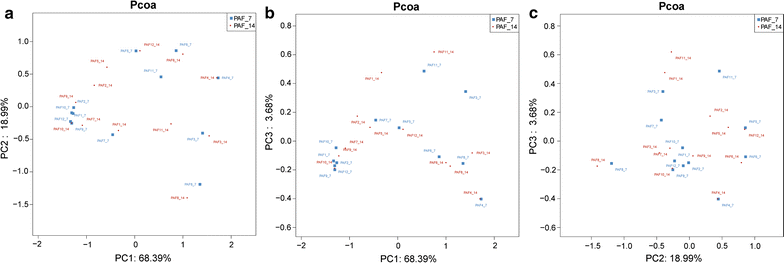Prenatal and postnatal antibiotic exposure influences the gut microbiota of preterm infants in neonatal intensive care units
- PMID: 29554907
- PMCID: PMC5858143
- DOI: 10.1186/s12941-018-0264-y
Prenatal and postnatal antibiotic exposure influences the gut microbiota of preterm infants in neonatal intensive care units
Abstract
Background: To explore the influences of prenatal antibiotic exposure, the intensity of prenatal and postnatal antibiotic exposure on gut microbiota of preterm infants and whether gut microbiota and drug resistant strains in the neonatal intensive care unit (NICU) over a defined period are related.
Methods: Among 28 preterm infants, there were two groups, the PAT (prenatal antibiotic therapy) group (12 cases), and the PAF (prenatal antibiotic free) group (12 cases). Fecal samples from both groups were collected on days 7 and 14. According to the time of prenatal and postnatal antibiotic exposure, cases were divided into two groups, H (high) group (11 cases) and L (low) group (11 cases), and fecal samples on day 14 were collected. Genomic DNA was extracted from the fecal samples and was subjected to high throughput 16S rRNA amplicon sequencing. Bioinformatics methods were used to analyze the sequencing results.
Results: Prenatal and postnatal antibiotic exposure exercised influence on the early establishment of intestinal microflora of preterm infants. Bacteroidetes decreased significantly in the PAT group (p < 0.05). The number of Bifidobacterium significantly decreased in the PAT group and H group (p < 0.05). The early gut microbiota of preterm infants with prenatal and postnatal antibiotic exposure was similar to resistant bacteria in NICU during the same period.
Conclusion: Prenatal and postnatal antibiotic exposure may affect the composition of early gut microbiota in preterm infants. Antibiotic-resistant bacteria in NICU may play a role in reshaping the early gut microbiota of preterm infants with prenatal and postnatal antibiotic exposure.
Keywords: Anti-bacterial agents; Gastrointestinal microbiome; High-throughput nucleotide sequencing; Infant, premature; Intensive care unit, neonatal.
Figures








Similar articles
-
Preterm infant gut colonization in the neonatal ICU and complete restoration 2 years later.Clin Microbiol Infect. 2015 Oct;21(10):936.e1-10. doi: 10.1016/j.cmi.2015.06.003. Epub 2015 Jun 15. Clin Microbiol Infect. 2015. PMID: 26086569
-
Randomized Control Trial of Human Recombinant Lactoferrin: A Substudy Reveals Effects on the Fecal Microbiome of Very Low Birth Weight Infants.J Pediatr. 2016 Jun;173 Suppl:S37-42. doi: 10.1016/j.jpeds.2016.02.074. J Pediatr. 2016. PMID: 27234409 Clinical Trial.
-
Antibiotics, gut bugs and the young.Nat Rev Microbiol. 2016 Jun;14(6):336. doi: 10.1038/nrmicro.2016.73. Epub 2016 May 3. Nat Rev Microbiol. 2016. PMID: 27140687
-
Antibiotic perturbation of the preterm infant gut microbiome and resistome.Gut Microbes. 2016 Sep 2;7(5):443-9. doi: 10.1080/19490976.2016.1218584. Epub 2016 Jul 29. Gut Microbes. 2016. PMID: 27472377 Free PMC article. Review.
-
Pathogenesis of necrotising enterocolitis: The impact of the altered gut microbiota and antibiotic exposure in preterm infants.Acta Paediatr. 2021 Feb;110(2):433-440. doi: 10.1111/apa.15559. Epub 2020 Sep 28. Acta Paediatr. 2021. PMID: 32876963 Review.
Cited by
-
Antimicrobial Stewardship: A Correct Management to Reduce Sepsis in NICU Settings.Antibiotics (Basel). 2024 Jun 3;13(6):520. doi: 10.3390/antibiotics13060520. Antibiotics (Basel). 2024. PMID: 38927186 Free PMC article. Review.
-
Persistent metagenomic signatures of early-life hospitalization and antibiotic treatment in the infant gut microbiota and resistome.Nat Microbiol. 2019 Dec;4(12):2285-2297. doi: 10.1038/s41564-019-0550-2. Epub 2019 Sep 9. Nat Microbiol. 2019. PMID: 31501537 Free PMC article.
-
Early life gut microbiome and its impact on childhood health and chronic conditions.Gut Microbes. 2025 Dec;17(1):2463567. doi: 10.1080/19490976.2025.2463567. Epub 2025 Feb 7. Gut Microbes. 2025. PMID: 39916516 Free PMC article. Review.
-
Effects of Perinatal Antibiotic Exposure and Neonatal Gut Microbiota.Antibiotics (Basel). 2023 Jan 28;12(2):258. doi: 10.3390/antibiotics12020258. Antibiotics (Basel). 2023. PMID: 36830169 Free PMC article. Review.
-
Programming Factors of Neonatal Intestinal Dysbiosis as a Cause of Disease.Int J Mol Sci. 2023 Mar 17;24(6):5723. doi: 10.3390/ijms24065723. Int J Mol Sci. 2023. PMID: 36982799 Free PMC article. Review.
References
MeSH terms
Substances
LinkOut - more resources
Full Text Sources
Other Literature Sources
Medical

